Airfix 1/48 scale
Hawker Fury Mk.I
by Roland Sachsenhofer

With the last years of the 1930s, the era of the biplane in military use finally came to an end. Although it was a farewell, it was a grand departure! The Hawker Fury I can be counted among the top products of a design concept oriented towards the traditional, which made the most of concepts from the first decade of powered flight.
What can be counted among these traditional features? The biplane configuration dates back to times when aerodynamic research had little to offer for the theoretical calculation of the lift of certain airfoil types. Experience determined the procedure and a quantitative enlargement of the wings had to appear as the faster way to better flight performance than a qualitative improvement of the wing profiles. The associated loss of performance due to bracing and strutting was accepted as necessary.
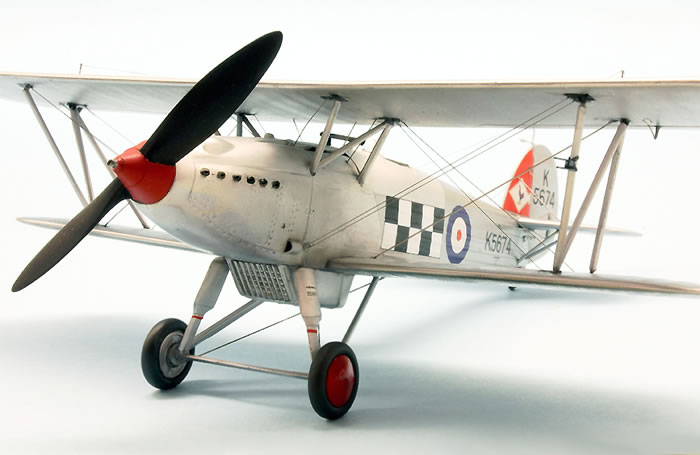
Looking at the Fury I from the outside, one notices the two-part superstructure with a covered lattice work structure as well as a metal covered section. This feature also continues a tradition that was formulated in the early days of aviation. At the same time as the Fury was being designed, experiments were already being conducted in Europe with self-supporting fuselage half-shells made of light metal, an approach that was to be the future.
Conventional thinking is also demonstrated by the rigid and strutted undercarriage; the tail spur instead of the tail wheel reflects a reality in which flight operations were still conducted exclusively from unpaved grass runways.

The open cockpit also illustrates a line of development that is coming to an end. Not only the lack of glazing, but also the absence of such simple and seemingly obvious protective devices as a roll bar or headrest show the Fury to be one of the last representatives of its kind.
I would like to conclude this list with a brief reference to the fixed two-blade propeller, a technology that was also soon to be replaced by the variable pitch propeller.
The Fury's maiden flight took place on 25 March 1931, and the first production aircraft entered service as early as May. In the two versions built, around 200 examples were used by the Royal Air Force as fighter aircraft. The Hawker Fury was powered by a 525 hp R&R Kestrel II, which gave the Fury a top speed of over 300 km/h. The basic design was successful, and the fighter was able to take off from the ground.
The successful basic design prompted further developments that would eventually lead to the Fury II. One innovation was the use of a 640 hp Kestrel VI, which would give the design a top speed of 359 kph. From 1935, after 160 machines had been built, production was switched to the Fury II.
Engineering legend Sidney Camm, responsible for the development of the Fury, was to draw up a proposal for the development of a modernised "monoplane Fury" shortly afterwards. Continuing the line of using stormy weather phenomena for naming, the new design was called "Hurricane". In this great design, some of the features just discussed were modernised. However, retractable landing gear, enclosed pilot's cockpit and armament literally reinforced several times over cannot hide the close relationship between Fury and Hurricane.
Elegant and powerful for its day, the Fury also enjoyed great interest from other air forces. Recent users included Persia with 16, Portugal with 3 and, last but not least, Yugoslavia with a total of 10 aircraft. The latter featured covered wheels, a doubled number of machine guns and was powered by a 745 hp Kestrel XVI. Incidentally, Yugoslavia produced an additional 40 of its own Furys under licence, built by Ikarus and Zmaj.
The Fury only saw combat action against Italian troops in East Africa in 1941; pilots of Yugoslavian Furys had to learn bitter lessons in the same year that the days of the Fury as a fighter had long since expired. In the battles against the German invaders, the few available Furys were taken out of the sky by Bf 109s in a veritable massacre, if not already devastated.
My model shows a Fury I in the colours of No.43 Squadron of the Royal Air Force; these colours were also used to restore an airworthy Fury that has been on display at the Imperial War Museum in Duxford since 2012.
The kit parts are from a reissue of a kit first released in 1980.
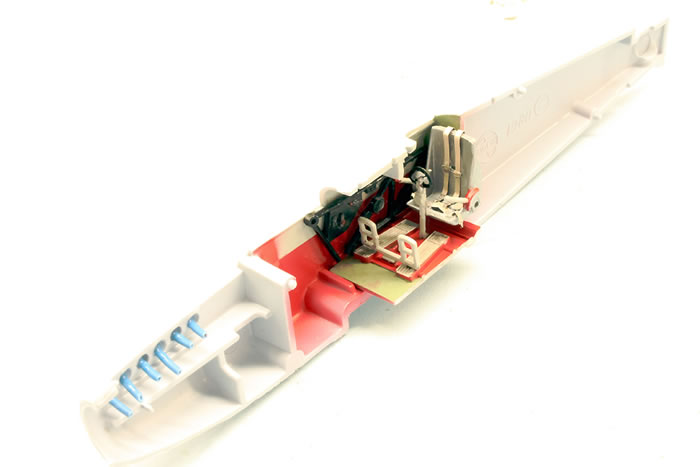
In 2013 Airfix put the original contents in a nicely decorated box, whose attractive and atmospheric lid image contributed a lot to my decision to buy. It was clear to me from the start that I wanted to achieve exactly such a look. It should not only show polished and shiny metal, but at the same time represent a much flown specimen - with such attractive exhaust stripes as you can see in the picture.
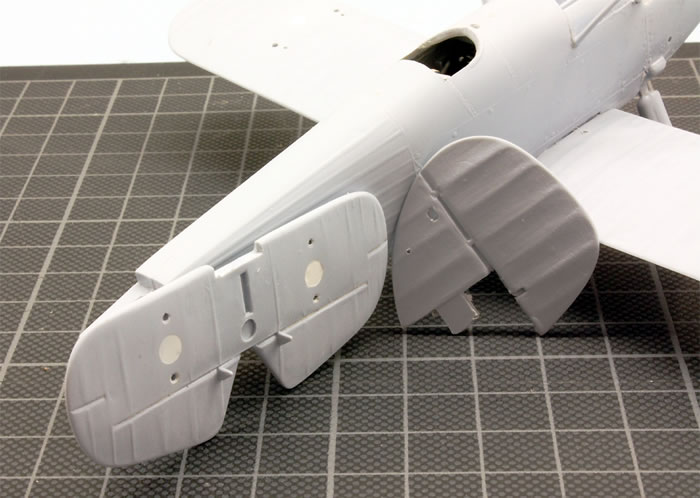
This was, of course, a touch of megalomania: my skills are not sufficient to create a braced biplane in such detailed coherence from outdated moulds that would be anything but easy to work with. But it was to remain a beautiful goal towards which I could aim my efforts.
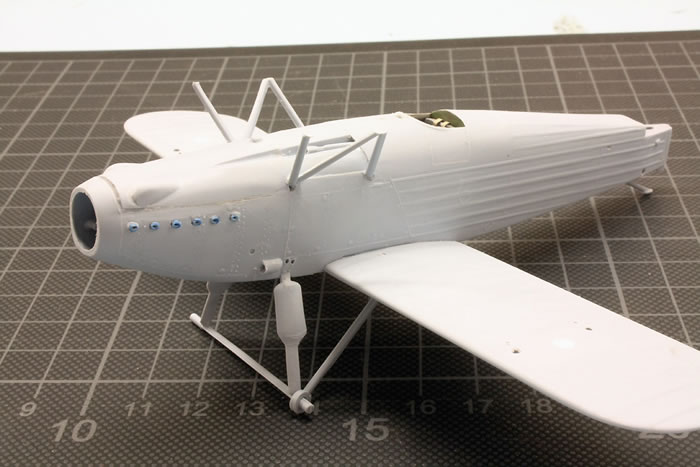
What was done to achieve this goal? First of all, I used sandpaper to minimise the overly obvious ribs and stringer structures on the fuselage and surfaces. During this step I was able to drill the holes for the tension wires.
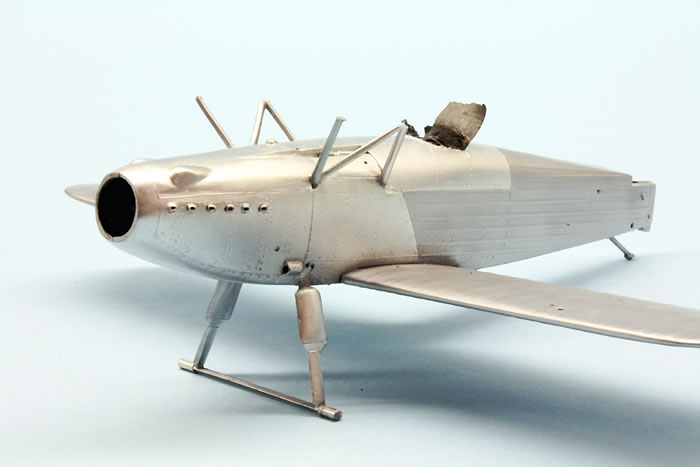
Furthermore the cockpit, which was left more or less… well, basic by Airfix, was upgraded. Here an easily accessible research based on the beautiful Duxford-Fury helped, on the other hand a no longer used Hurricane kit donated a few "Hawker-suitable" parts for the latticework and the interior equipment.

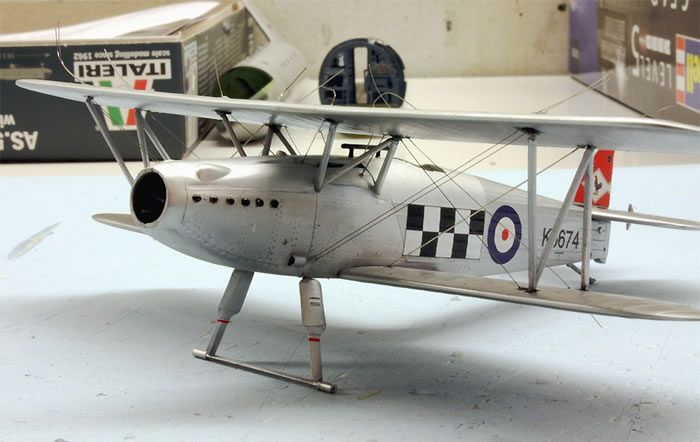
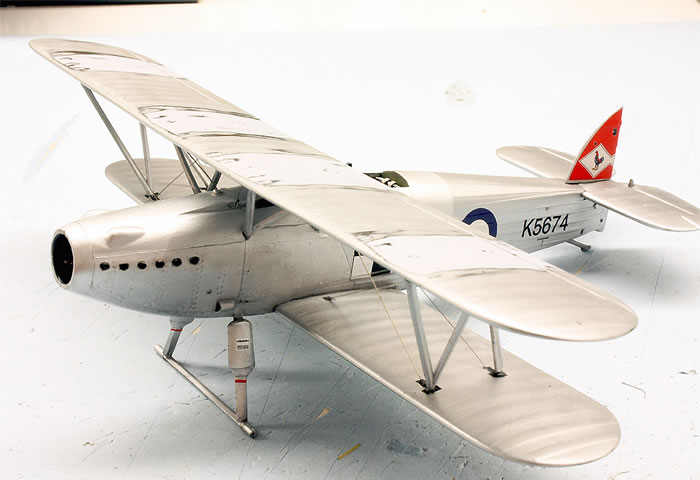
The rudder linkages were scratchbuilt, as were all the externally mounted details, such as the two pitot tubes on the left N-strut. The work on the bracing brought only reasonable and "exciting" effort, but no problems, thanks to the solid "aerodynamic" tension wires from the manufacturer "R&B Productions". The technique of anchoring the tension wires at one end in a deep hole by CA glue, then threading them through a drilled hole on the opposite face, then fixing the whole thing in place with the fastest curing CA glue while keeping it under tension, worked well.
As my expectations were not too high considering the design of the aged components, I am satisfied with the result. In any case, it gave me a lot of pleasure - and also a little courage to dare once again to build one of the so shapely and elegant biplanes of the thirties!
If you are interested in the building process, please have a look here on Scalemates:
https://www.scalemates.com/profiles/mate.php?id=10148&p=albums&album=66900
As ever, remarks will be appreciated: ro.sachsenhofer@gmx.at
Model, Images and Text Copyright ©
2021 by Roland Sachsenhofer
Page Created 6 April, 2021
Last Updated
6 April, 2021
Back to HyperScale Main Page

|
Home
| What's New | Features | Gallery | Reviews | Reference | Resource Guides | Forum |